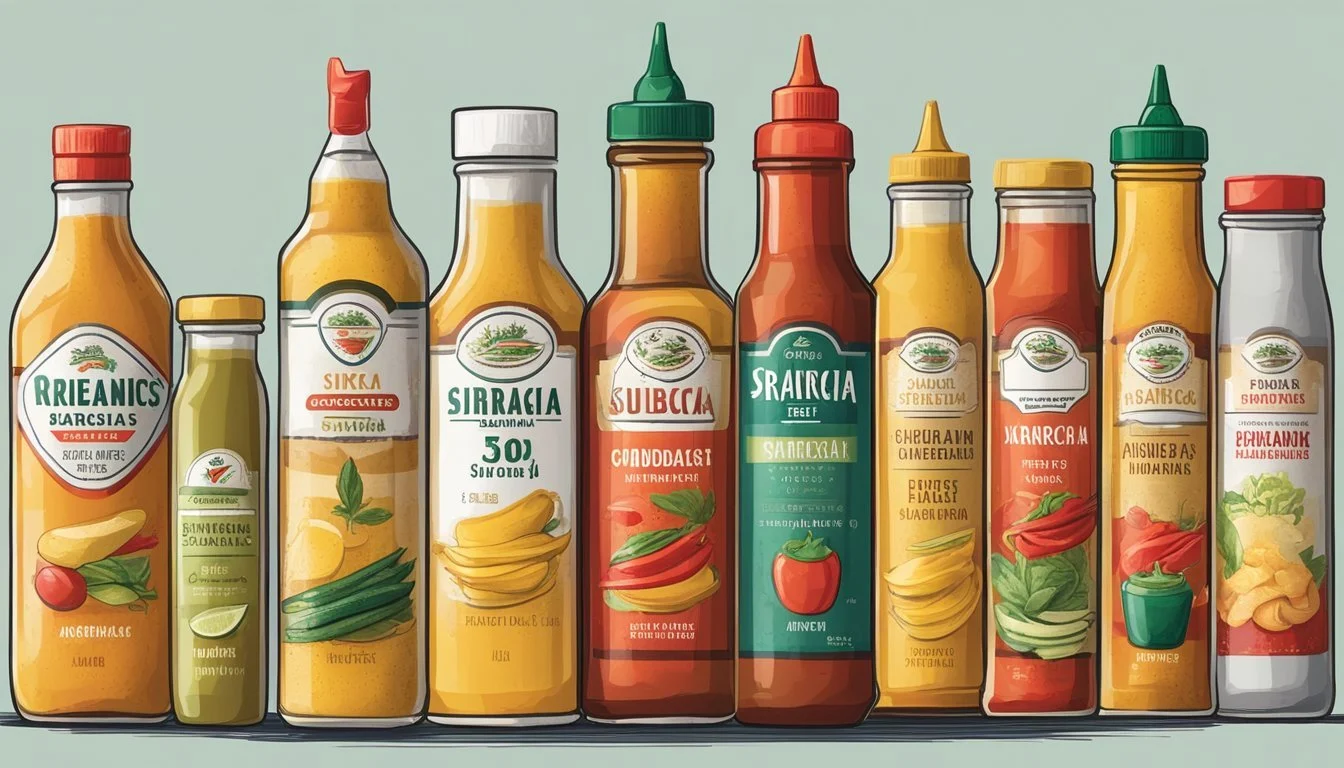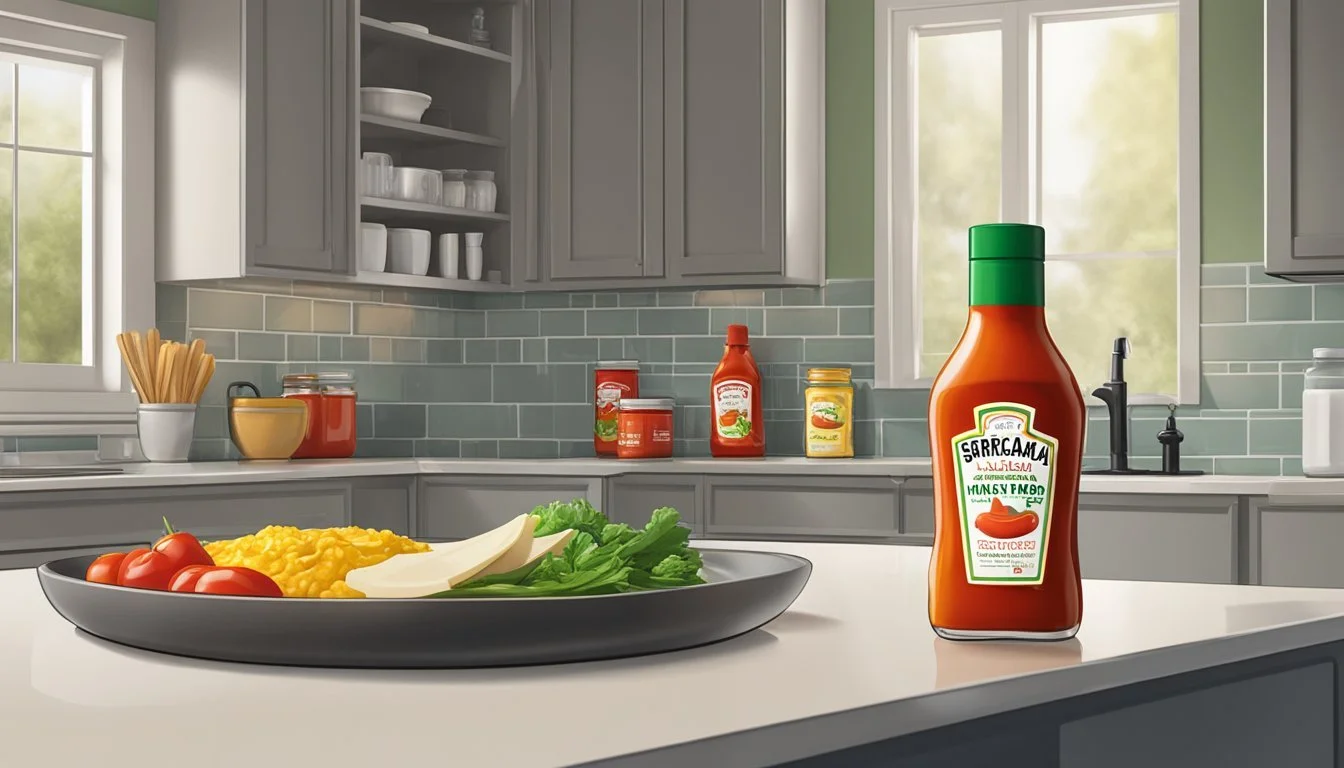Sriracha Mustard Substitutes
Top Alternatives for Spicing Up Your Recipes
Sriracha mustard is a unique condiment that combines the tangy depth of mustard with the fiery kick of Sriracha sauce. This hybrid of flavors has gained popularity for its versatility and the zesty boost it provides to a variety of dishes. From sandwiches and burgers to dressings and marinades, Sriracha mustard imparts a distinct spicy and robust taste that many have come to love. However, when Sriracha mustard isn't available or if one is looking to experiment with other options, there are several viable substitutes that can be used to achieve a similar flavor profile.
Substituting Sriracha mustard in recipes requires understanding the balance between spice, tanginess, and sweetness that it provides. Ingredients such as wasabi, gochujang, and sambal oelek offer a similar heat and complexity. Wasabi, known for its sharp, pungent heat, should be used sparingly, while gochujang contributes a savory, sweet heat due to its fermented soybean content. Sambal oelek, made from ground chilies, vinegar, garlic, and salt, delivers a straightforward chili heat that can closely mimic the spice of Sriracha. These substitutes can be adjusted according to the desired intensity of flavor and can be paired with different types of mustard to customize the condiment to one's particular taste preferences.
Understanding Sriracha Mustard
Sriracha Mustard is a unique condiment that combines the fiery taste of sriracha sauce with the tangy flavor of mustard. It is known for its versatility and can add a spicy kick to a variety of dishes.
Composition of Sriracha Mustard:
Sriracha: A type of hot sauce or chili sauce made from a paste of chili peppers, distilled vinegar, garlic, sugar, and salt.
Mustard: This component is a paste made from ground mustard seeds, turmeric, and additional ingredients such as water, wine, vinegar, and various seasonings.
Taste and Consistency:
Flavor: The combination of sriracha and mustard creates a taste that is spicy with a pronounced vinegar and garlic presence. It is less sharp than plain mustard but retains a distinctive heat level.
Heat Level: The spiciness comes from the chili peppers in sriracha, which offers a different but complementary heat compared to the pungency of mustard.
Texture: Typically, sriracha mustard has a smooth consistency, although it may have some texture depending on the coarseness of the ground mustard seeds.
Culinary Uses:
As a spread on sandwiches and burgers.
Marinades and dressings benefit from its tanginess and heat.
It serves as a dip for snacks and appetizers.
Ingredients' Unique Features:
Sriracha is often fermented, which adds complexity to its flavor profile.
Mustard imparts a tangy taste and acts as an emulsifier in sauces and dressings.
In summary, Sriracha Mustard is a condiment that offers a blend of heat, tanginess, and a hint of sweetness. Its consistency makes it suitable for various culinary applications, and it offers a distinctive taste that enhances the flavor profile of foods. It's a must-try for those who appreciate a blend of spice and tang in their meals.
Sriracha Mustard Substitutes Overview
When seeking alternatives for sriracha mustard, it is useful to consider both the heat and tanginess that this condiment brings to various dishes. Sriracha mustard is a hybrid sauce combining traditional sriracha's heat with mustard's sharpness. Thus, when looking for substitutes, one should aim for options that provide a balance of spiciness and acidity.
Suitable sriracha substitutes include:
Gochujang: For a similar spice profile with added sweetness, one may employ gochujang sauce in a 1:1 ratio.
Sambal Oelek: A chili paste with vinegar and garlic, which maintains the spiciness and can be used equally to sriracha mustard.
Peri-Peri Sauce: While hotter, it offers a garlicky flavor with citrus notes, suitable for marinades and can be adjusted according to taste.
Substitute Note Gochujang Start with a 1:1 ratio, add more to taste if needed. Sambal Oelek Use in equal amounts to sriracha mustard. Peri-Peri Begin with less and adjust due to its intense heat.
For a DIY approach, a mix of hot sauces, mustard, and a splash of vinegar might fill the gap. This homemade concoction allows one to tailor the heat and tanginess to personal preference. Ingredients such as cayenne pepper provide a heat punch without overshadowing the mustard's robust flavor. Substitute with varying proportions based on the desired spice level.
In selecting sriracha substitutes, they must consider how the alternative complements the other flavors in a dish. Each substitute offers a unique flavor profile that can elevate the intended recipe while maintaining the essential characteristics of sriracha mustard.
Hot Sauce Alternatives
When seeking substitutes for Sriracha mustard, it is important to consider the unique flavor profile of each alternative to best match the heat and taste of the original sauce. The following hot sauce alternatives offer a range of flavors from sweet and tangy to smoky and spicy.
Gochujang
Gochujang is a Korean paste that combines heat with a mellow sweetness. Made from chili flakes, fermented soybeans, rice, and salt, it introduces a deep, umami-rich dimension to dishes.
Sambal Oelek
Sambal Oelek focuses on pure chili flavor without added sweetness. This Indonesian sauce consists mainly of ground chili peppers and can be a fitting alternative for those who prefer straightforward heat.
Harissa
For Harissa, the North African region offers a paste blending roasted red peppers, Baklouti pepper, serrano peppers, and other hot chili peppers. Spices like coriander, caraway seeds, and garlic provide an aromatic kick.
Chili Garlic Sauce
Chili Garlic Sauce is an excellent alternative, bringing a garlicky flavor alongside the heat. It's a thick, chunky style sauce that suits those who enjoy a vibrant chili taste with a noticeable garlic presence.
Tabasco
Tabasco, originating from Louisiana, is a vinegar-based hot sauce made from Tabasco peppers. It’s sharper and tangier, perfect for those who appreciate a sauce with a vinegar bite.
Nando's Peri-Peri Sauce
Nando's Peri-Peri Sauce is a flavorful option made from the African bird's eye chili. Its unique piquancy and slight citrus flavor make it a versatile choice for various dishes.
Tapatío
Tapatío is a Mexican-style hot sauce with a medium heat level. It delivers a balance of spices that is different from Sriracha but can bring a zesty flavor to meals.
Cholula
Finally, Cholula Hot Sauce is well-loved for its blend of pequin and arbol peppers. It has a moderate heat and a signature spice blend that complements a wide range of foods.
Other Sriracha Substitutes
While Sriracha mustard is a popular spicy condiment, various alternatives can cater to different preferences or simply offer a new twist on heat and flavor.
Sweet Chili Sauce
Sweet chili sauce provides a balance of sweetness with a milder heat profile. It is an ideal substitute for Sriracha mustard in dishes that benefit from a touch of sugar without overwhelming spiciness. Reputable brands like Mae Ploy offer this sauce, which combines red chilies, vinegar, and garlic with a sweet undertone.
Flavor Profile: Sweet, mildly spicy, tangy
Best Used In: Dipping sauces, glazes, marinades
Chipotle Ketchup
Chipotle ketchup infuses the smoky taste of chipotle peppers into a tomato base, resulting in a rich and smoky sauce. This substitute not only adds heat but also imparts a deep, barbecue-like flavor that can enhance burgers, fries, and more.
Flavor Profile: Smoky, mildly sweet, tangy
Best Used In: Burgers, fries, barbecue dishes
Chili Crisp
Chili crisp offers a complex flavor with crunchy texture, integrating chili flakes, soybean oil, and various aromatic spices. Brands like Fly By Jing have popularized this condiment, making it a go-to for an instant flavor boost with a crispy bite.
Flavor Profile: Savory, spicy, crispy
Best Used In: Toppings for rice dishes, noodles, soups
DIY Substitutes
Crafting homemade versions of Sriracha mustard combines the unique heat of Sriracha with the tanginess of mustard, ideal for those who favor a custom level of spiciness and flavor.
Homemade Sriracha
To make homemade Sriracha, one needs a blend of red jalapeno peppers, garlic, sugar, salt, and distilled white vinegar. The process involves pureeing the peppers with garlic, sugar, and salt, then fermenting the mixture for a few days before adding vinegar and boiling it down to the desired consistency. This DIY practice inherits its method from the traditional preparation popular in Southeast Asia, particularly the Si Racha district in Thailand.
Peppers: Blend fresh red jalapeno peppers until smooth.
Garlic: Crush and mix with pureed peppers.
Sugar and Salt: Add to taste, balancing sweetness and heat.
Vinegar: Distill white vinegar gives the Sriracha its distinctive tang.
Consistency: Aim for a thick paste, which can be used as a dip or condiment.
Chili Paste Mix
For a Chili Paste Mix that mimics Sriracha mustard, the key ingredients include chili powder, garlic powder, red pepper flakes, oil, and a bit of vinegar to adjust acidity. Mixing these ingredients forms a thick paste similar in texture to Sriracha but with a distinctive flair based on which types of chili are used. It can be a versatile condiment or rub for cooking when mustard is out of reach.
Chili Flakes and Powder: Use this for an immediate burst of heat.
Garlic Powder: Adds a bold, aromatic touch.
Oil and Vinegar: Combine to achieve the right texture and piquancy.
Adjustments: Modify proportions for a personalized taste, balancing heat with a slight hint of lemon or onions for complexity.
Incorporating Substitutes into Recipes
When using sriracha mustard substitutes in recipes, one should take into account the flavor profile, heat level, and consistency of the substitute to ensure it complements the dish effectively.
Marinades
In marinades, the amalgamation of ingredients typically includes acid, oils and flavorful components. To replicate sriracha mustard's unique heat and tanginess:
For the acidic component, lemon juice or vinegar can be used.
Oil serves as a binder and flavor carrier; olive oil is a frequent choice.
Sweetness can be adjusted with sugar to balance the heat.
Minced garlic or garlic paste often brings depth.
If extra heat is desired, a chili paste such as sambal oelek can substitute for the pungency of mustard.
The consistency should be suitable for coating, so adjustments with water or additional oil might be necessary if the substitute is particularly thick.
Dips and Spreads
Texture is vital for dips and spreads; they should be smooth yet substantial enough to cling to the dipped food:
To substitute sriracha mustard in a dip, ketchup can provide a milder heat and a sweet base.
A paste such as gochujang offers a sweet and spicy profile, but its thickness might require thinning with vinegar or lemon juice.
Fish sauce can add umami and complement the chili heat in the absence of sriracha mustard.
For sandwiches, the substitute should not be too runny; a thicker chili paste might need to be mixed with a bit of mustard to achieve the desired spreadable consistency.
Cooking Ingredients
As a cooking ingredient, sriracha mustard imparts heat and flavor to the dish. Substitutes can be used in various ways:
When creating a rub for proteins, dry heat comes from ground chilies, while mustard powder provides the tang and thickens the rub.
During cooking, the substitute condiment should blend well with the other ingredients without overpowering them.
If the dish requires sweetness, additional sugar might be necessary if the sriracha substitute is less sweet than sriracha mustard.
It's important to introduce substitutes such as chili paste or a mix of vinegar and spices early in the cooking process to fully integrate their flavors.
Conclusions on Sriracha Mustard Substitutes
When seeking substitutes for sriracha mustard, an array of alternatives are available that cater to varying preferences in taste and spiciness. While sriracha itself imparts a distinct flavor characterized by garlic-vinegar notes and moderate heat, combining it with mustard typically adds tangy and pungent dimensions to the condiment.
Gochujang sauce is recommended as an alternative, offering a similar sweet and spicy profile. However, it should be noted that one tablespoon of sriracha may be replaced with half a tablespoon of plain gochujang, adjusting based on tasting.
Another spicy condiment, Sambal Oelek, made with ground chili peppers, also provides a comparable kick. This substitute leans more toward the sriracha side with its pure chili flavor, backed by hints of vinegar.
Louisiana Hot Sauce, while spicier, could be another sriracha mustard substitute, with a substitution ratio of one tablespoon of sriracha to one-quarter tablespoon of Louisiana Hot Sauce. The bright, peppery taste is reminiscent of sriracha's heat and may complement mustard well.
For those who prioritize the acidic component of sriracha mustard, white vinegar offers a sharp substitute. Care should be taken to add it gradually due to its potency.
Lastly, mustard itself can be a substitute, which may already be present in the pantry. It provides a robust tanginess, which, while not spicy, can mimic the piquancy of sriracha mustard to some extent.
Sriracha Substitute Taste Profile Spicier Note on Usage Gochujang Sauce Sweet and spicy No Start with half the amount. Sambal Oelek Pure chili flavor No Use same amount as sriracha. Louisiana Hot Sauce Peppery, very spicy Yes Use less, 1:0.25 sriracha ratio. White Vinegar Sharp, acidic No Add incrementally, tasting often. Mustard Tangy, pungent No Can add robustness without heat.
In conclusion, one may confidently select a sriracha mustard substitute that aligns with their specific flavor and heat preferences, ranging from tangy and pungent to sweet, spicy, and very spicy options. It's imperative to adjust these alternatives to suit the intended use, always starting with a conservative quantity and adding more as needed after tasting.








